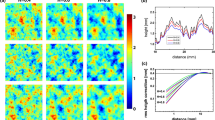Abstract
Recently, we showed that tactile speed estimates are modified by the spatial parameters of moving raised-dot surfaces, specifically dot spacing but not dot disposition (regular, irregular) or density. The purpose of this study was to determine the extent to which tactile roughness perception resembles tactile speed with respect to its dependence and/or independence of the spatial properties of raised-dot surfaces. Subjects scaled the roughness of surfaces displaced under the finger. Dot spacing (centre-to-centre) ranged from 1.5 to 8.5 mm in the direction of the scan (longitudinal). Mean dot density varied from 2.2 to 46.2 dots/cm2. Dot disposition was varied: repeating rows (periodic) or quasi-random (non-periodic). In the first experiment (n = 8), the periodic and non-periodic surfaces were matched for mean dot density. Roughness showed a monotonic increase with 1/dot density, but non-periodic surfaces were judged to be smoother than the periodic surfaces. Subjective equality was obtained when the data were re-expressed relative to longitudinal SP. In the second experiment (n = 7), the periodic and non-periodic surfaces were matched for longitudinal dot spacing. Perceptual equivalence was observed when the results were plotted relative to dot spacing, but not 1/dot density. Dot spacing in the orthogonal direction (transverse) was excluded as a contributing factor. Thus, as found for tactile speed scaling, roughness is critically dependent on longitudinal dot spacing, but independent of dot disposition and dot density (over much of the tested range). These results provide a set of predictions to identify cortical neurones that play critical roles in roughness appreciation.




Similar content being viewed by others
References
Blake DT, Hsiao SS, Johnson KO (1997) Neural coding mechanisms in tactile pattern recognition: the relative contributions of slowly and rapidly adapting mechanoreceptors to perceived roughness. J Neurosci 17:7480–7489
Burton H, Sinclair RJ (1994) Representation of tactile roughness in thalamus and somatosensory cortex. Can J Physiol Pharmacol 72:546–557
Connor CE, Johnson KO (1992) Neural coding of tactile texture: comparison of spatial and temporal mechanisms for roughness perception. J Neurosci 12:3414–3426
Connor CE, Hsiao SS, Phillips JR, Johnson KO (1990) Tactile roughness: neural codes that account for psychophysical magnitude estimates. J Neurosci 10:3823–3836
Dépeault A, Meftah E-M, Smith AM, Chapman CE (2006) Tactile perception of roughness: contribution of surface periodicity. Abstr Soc Neurosci, Progr no. 804.2
Dépeault A, Meftah E-M, Chapman CE (2008) Tactile speed scaling: contributions of time and space. J Neurophysiol 99:1422–1434
DiCarlo JJ, Johnson KO (1999) Velocity invariance of receptive field structure in somatosensory cortical area 3b of the alert monkey. J Neurosci 19:401–419
Hollins M, Risner SR (2000) Evidence for the duplex theory of tactile texture perception. Percept Psychophys 62:695–705
Lawrence MA, Kitada R, Klatzky RL, Lederman SJ (2007) Haptic roughness perception of linear gratings via bare finger or rigid probe. Perception 36:547–557
Lederman SJ (1974) Tactile roughness of grooved surfaces: the touching process and effects of macro- and microsurface structure. Percept Psychophys 16:385–395
Lederman SJ, Taylor MM (1972) Fingertip force, surface geometry, and the perception of roughness by active touch. Percept Psychophys 12:401–408
Lederman SJ, Thorne G, Jones B (1986) Perception of texture by vision and touch: multidimensionality and intersensory integration. J Exp Psychol Hum Percept Perform 12:169–180
Meftah E-M, Belingärd L, Chapman CE (2000) Relative effects of the spatial and temporal characteristics of scanned surfaces on human perception of tactile roughness using passive touch. Exp Brain Res 132:351–361
Sathian K, Goodwin AW, John KT, Darian-Smith I (1989) Perceived roughness of a grating: correlation with responses of mechanoreceptive afferents innervating the monkey’s fingerpad. J Neurosci 9:1273–1279
Smith AM, Gosselin G, Houde B (2002) Deployment of fingertip forces in tactile exploration. Exp Brain Res 147:209–218
Stevens SS, Harris JR (1962) The scaling of subjective roughness and smoothness. J Exp Psychol 64:489–494
Tremblay F, Ageranioti-Belanger SA, Chapman CE (1996) Cortical mechanisms underlying tactile discrimination in the monkey I. Role of primary somatosensory cortex in passive texture discrimination. J Neurophysiol 76:3382–3403
Verrillo RT, Bolanowski SJ, McGlone FP (1999) Subjective magnitude of tactile roughness. Somatosens Mot Res 16:352–360
Yoshioka T, Gibb B, Dorsch AK, Hsiao SS, Johnson KO (2001) Neural coding mechanisms underlying perceived roughness of finely textured surfaces. J Neurosci 21:6905–6916
Zompa IC, Chapman CE (1995) Effects of cross-modal manipulations of attention on the ability of human subjects to discriminate changes in texture. Somatosens Mot Res 12:87–102
Acknowledgments
The authors thank the following for excellent technical assistance: René Albert, the late Richard Bouchoux, Marc Bourdeau, Marie-Thérèse Parent, and Christian Valiquette. Finally, we thank Trevor Drew for his helpful comments on the manuscript. The research was supported by grants from the Canadian Institutes of Health Research, CIHR (individual grant to CE Chapman; Group in Neurological Sciences), and the Groupe de Recherche sur le Système Nerveux Central (Fonds de la recherche en santé du Québec). A Dépeault is supported by a bursary from the CIHR.
Author information
Authors and Affiliations
Corresponding author
Rights and permissions
About this article
Cite this article
Dépeault, A., Meftah, EM. & Chapman, C.E. Tactile perception of roughness: raised-dot spacing, density and disposition. Exp Brain Res 197, 235–244 (2009). https://doi.org/10.1007/s00221-009-1907-1
Received:
Accepted:
Published:
Issue Date:
DOI: https://doi.org/10.1007/s00221-009-1907-1




